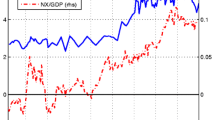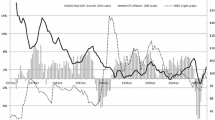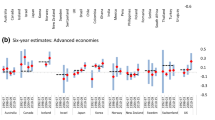Abstract
A flexible semi-parametric augmented Dickey Fuller (ADF) regression is proposed to explore real exchange rate dynamics for 16 countries over the twentieth century, and to estimate half-lives. Departing from existing literature, the present approach does not impose a functional form of the ADF regression and encompasses parametric extensions. Significant impediments to real exchange rates adjustment are found, and estimated half-lives are longer than those reported by earlier studies. These findings reveal a dismal PPP performance, difficulties in designing profitable strategies based on mean-reversion, complexities in production relocation policies by firms to reduce exchange rate risk, and carry implications for foreign subsidiary ownership structure.


Similar content being viewed by others
Notes
According to Keele (2008), these two approaches yield similar results in practice.
Thanks are due to Claude Lopez for kindly providing the data.
Running these models did not require extra computing resources, did not consume significant computational time, and thus did not entail computational costs. All estimations were conducted on an ordinary PC with Intel Pentium (i5) with 1.86 GHz processor and 4.0 GB RAM, with estimations taking a few seconds to converge, in line with the computing time required in Wang and Yang (2007). Indeed, Wang and Yang (2007), using Monte Carlo simulations, concluded that splines-based estimators of additive models are computationally expedient. This is due to the fact that in the present study, we follow Engle et al. (1986) and employ penalized regression splines instead of other competing nonlinear smoothers to estimate the semi-parametric ADF regression. Penalised regression splines use fewer parameters than other smoothers and are computationally efficient (Keele 2008).
Japan is added to these countries as the confidence interval encompasses 0. For Norway, there is a very small range of values for which the relation becomes marginally negative.
The inclusion of a deterministic trend yields qualitatively similar results (as in Lopez et al. 2005).
The dimension-reduction principle refers to the properties of the convergence rate of statistical models, and is analytically discussed in Stone (1985).
References
Allen DE, McAleer M, Peiris S, Singh AK (2016) Nonlinear time series and neural network models of exchange rates between the US dollar and major currencies. Risks 4:1–14
Bayraktar S (2009) The impact of exchange rate risk on international asset pricing under market structures. Rev Quant Finance Account 32:169–195
Berument MH, Dincer NN, Mustafaoglu Z (2012) Effects of growth volatility on economic performance—empirical evidence from Turkey. Eur J Oper Res 217:351–356
Carcano G, Fablo P, Stefani S (2005) Speculative trading in mean reverting markets. Eur J Oper Res 163:132–144
Chiu IM (2008) An empirical study of the long-run determinants of exchange rate. Rev Pac Basin Financ Mark Policies 11:389–409
Chu PKK (2016) Analysis and forecast of tracking performance of Hong-Kong exchange traded funds. Rev Pac Basin Financ Mark Policies 19:1650022
Dumas B (1992) Dynamic equilibrium and the real exchange rate in spatially separated world. Rev Financ Stud 5:153–180
Dumas B (1994) Partial equilibrium versus general equilibrium models of the international capital market. In: van der Ploeg F (ed) The handbook of international macroeconomics, 1st edn. Wiley-Blackwell, Hoboken, p 10
Dumitru I, Jianu I (2009) The Balassa-Samuelson effect in Romania—the role of regulated prices. Eur J Oper Res 194:873–887
Engle RF, Granger CWJ, Rice J, Weiss A (1986) Semi-parametric estimates of the weather-electricity relation. J Am Stat Assoc 81:310–320
Farnoosh R, Hajibi M, Mortavazi SJ (2014) A semiparametric estimation of the regression functions in the partially nonlinear autoregressive time series model. Appl Appl Math 9:573–591
Hastie TJ, Tibshirani R (1990) Generalized additive models. Chapman & Hall, Boca Raton
Hung MW, Jan YC (2002) Use of deviations from purchasing power parity and interest rate parity to clarify the 1997 Asian financial crisis. Rev Pac Basin Financ Mark Policies 5:195–218
Kanas A (2006) Purchasing power parity and Markov regime switching. J Money Credit Bank 38:1669–1687
Kao C, Wu WY, Hsieh WJ, Wang TY, Lin C, Chen LH (2008) Measuring the national competitiveness of South East Asian countries. Eur J Oper Res 187:613–628
Kapetanios G, Shin Y, Snell A (2003) Testing for a unit root in the nonlinear STAR framework. J Econom 112:359–379
Karemera D, Cole J (2010) ARFIMA tests for random walks in exchange rates in Asian, Latin American and African-Middle Eastern markets. Rev Pac Basin Financ Mark Policies 13:1–18
Keele J (2008) Semiparametric regression for social sciences. Wiley, Chichester
Kouvelis P, Axarloglou K, Sinha V (2001) Exchange rates and the choice of ownership structure of production facilities in supplying foreign markets. Manag Sci 47:1063–1080
Lipe R, Kormendi R (1994) Mean reversion in annual earnings and its implications for security valuation. Rev Quant Finance Account 4:27–46
Lopez C, Murray CJ, Papell DH (2005) State of the art unit root tests and purchasing power parity. J Money Credit Bank 3:361–369
Lowe TJ, Wendell RE, Hu G (2002) Screening location strategies to reduce exchange rate risk. Eur J Oper Res 136:573–590
Meligkotsidou L, Vrontos ID, Vrontos SD (2009) Quantile regression analysis of hedge fund strategies. J Empir Finance 16:264–279
Michael P, Nobay AR, Peel DA (1997) Transaction costs and nonlinear adjustment in real exchange rates: an empirical investigation. J Polit Econ 92:307–328
Mishra AV (2011) Australia’s equity home bias and real exchange rate volatility. Rev Quant Finance Account 37:223–244
Moretti M, Stolz SM, Swinburn M (2008) Stress testing at the IMF, WP/08/206
Murray CJ, Papell DH (2002) The purchasing power parity persistence paradigm. J Int Econ 56:1–19
Nieh CC, Wang YS (2005) ARDL approach to exchange rate overshooting. Rev Quant Finance Account 25:25–55
O’Connell PGJ, Wei SJ (2002) “The bigger they are, the harder they fall”: retail price differences across U.S. cities. J Int Econ 56:21–53
Obstfeld M, Rogoff K (2000) The six major puzzles in international macroeconomics: is there a common cause? In: Bernanke B, Rogoff K (eds) NBER macroeconomics. MIT Press, Cambridge, pp 339–390
Ohanian LE, Stockman AC (1997) Arbitrage costs and exchange rates. Discussion Paper, University of Rochester
Okunade AA, Haryanto H, Means DB (1996) Testing the unbiasedness hypothesis of foreign exchange rates and the analysis of transformations. Rev Quant Finance Acc 6:39–46
Peroni C (2009) A nonparametric investigation of risk premia. Stud Nonlinear Dyn Econom 13:1–40
Rogoff K (1996) The purchasing power parity puzzle. J Econ Lit 34:647–668
Sercu P, Uppal R, Van Hulle C (1995) The exchange rate in the presence of transaction costs: implications for purchasing power parity. J Finance 50:1309–1319
Shintani M (2006) A nonparametric measure of convergence towards purchasing power parity. J Appl Econ 21:589–604
Sollis R, Leybourne S, Newbold P (2002) Tests for symmetric and asymmetric nonlinear reversion in exchange rates. J Money Credit Bank 34:686–700
Stone CJ (1985) Additive regression and other nonparametric models. Ann Stat 10:1040–1053
Tabak BM, Lima EJA (2009) Market efficiency of Brazilian exchange rate: evidence from variance ratio statistics and technical trading rules. Eur J Oper Res 3:814–820
Tanggaard C (1997) Nonparametric smoothing of the yield curve. Rev Quant Finance Account 9:251–267
Taylor AM (2002) A century of purchasing power parity. Rev Econ Stat 84:139–150
Taylor MP, Sarno L (1998) Linear and nonlinear mean reversion in real exchange rates: reconciling the empirical evidence. University of Oxford, Oxford
Taylor MP, Peel DA, Sarno L (2001) Nonlinear mean reversion in real exchange rates: toward a solution to the purchasing power parity puzzles. Int Econ Rev 42:1015–1042
Wang L, Yang J (2007) Spline backfitted kernel smoothing of nonlinear additive autoregression models. Ann Stat 35:2474–2503
Wood S (2006) Generalized additive models. Chapman & Hall, Boca Raton
Yongjian E, Gu AY, Yang CC (2009) Real exchange rate behavior under the Peg: evidence from the Chinese RMB and the Malaysian MYR. Rev Pac Basin Financ Mark Policies 12:141–158
Acknowledgements
We wish to sincerely thank an anonymous referee and the Editor of this Journal for their important comments and suggestions which significantly improved the paper.
Author information
Authors and Affiliations
Corresponding author
Rights and permissions
About this article
Cite this article
Kanas, A., Kotios, A. & Zervopoulos, P.D. Semi-parametric real exchange rates dynamics. Rev Quant Finan Acc 52, 643–656 (2019). https://doi.org/10.1007/s11156-018-0720-y
Published:
Issue Date:
DOI: https://doi.org/10.1007/s11156-018-0720-y




